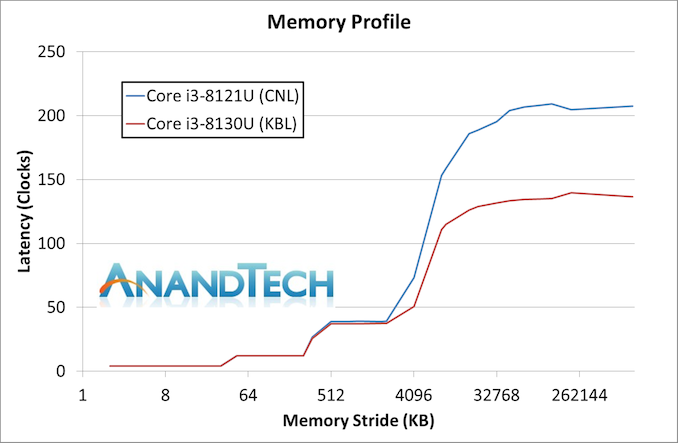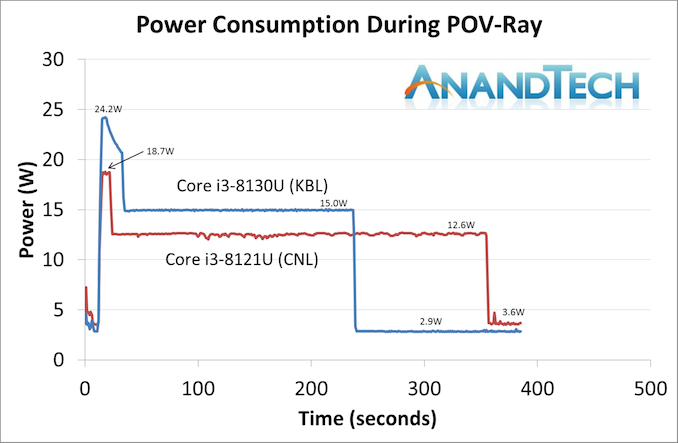Intel's 10nm Cannon Lake and Core i3-8121U Deep Dive Review
by Ian Cutress on January 25, 2019 10:30 AM ESTCPU Performance: Memory and Power
Memory
With the same memory setup as the standard Skylake-style core, without any other improvements, we should expect Cannon Lake to perform exactly similar. Here’s a recap of the memory configuration:
| Memory Comparison | ||
| Skylake Desktop | Cannon Lake | |
| L1-D Cache |
32 KiB/core 8-way |
32 KiB/core 8-way |
| L1-I Cache |
32 KiB/core 8-way |
32 KiB/core 8-way |
| L2 Cache |
256 KiB/core 4-way |
256 KiB/core 4-way |
| L3 Cache |
2 MiB/core 16-way |
2 MiB/core 16-way |
| L3 Cache Type | Inclusive | Inclusive |
For this test we put our Cannon Lake and Kaby Lake processors through our Memory Latency Checker test. Both systems had turbo modes disabled, forcing them to run at 2.2 GHz for parity and a direct microarchitecture comparison.
In this instance we see very little different between the two through the caches of the chip. Up to about 2MiB, both chips perform practically identical. Beyond this however, going out to main memory, there is a big discrepancy between the Kaby Lake and the Cannon Lake processor. In essence, accessing Cannon Lake main memory has an additional 50% latency.
At first we thought this was a bug. For both systems to have dual channel memory and running DDR4-2400, something had to be wrong. We double checked the setups – both systems were running in dual channel mode, giving the same memory bandwidth. The Cannon Lake processor was running at DDR4-2400 17-17-17, whereas the Kaby Lake system was at DDR4-2400 16-16-16 (due to memory SPD differences), which isn’t a big enough change to have such a big difference. The only reason we can come up with is that the memory controller on Cannon Lake must have additional overhead from the core to the memory controller – either a slower than expected PLL or something.
Power
Measuring the power of these thermally limited systems is somewhat frustrating in that we are at the whims of the quality of silicon at play. Bad silicon can get hotter faster, causing thermal throttling, or it depends on how the systems are set up for the peak power numbers. We use AIDA’s power monitoring tool to give us the power numbers for the CPUs during our POV-Ray test.
If you saw our How Intel Measures TDP article, you may be familiar with the concept of Power Limits. Intel processors have several power limits set in firmware – these values are set by the system manufacturer, and Intel provides ‘guidelines’. The two key values are Power Limit 1 (PL1), which describes a steady state scenario, and Power Limit 2 (PL2) which describes a turbo scenario. The reason why the system manufacturer gets control of these is because they might put a high wattage processor into a small form factor system, and need to manage performance – this is why we sometimes see a Core i7 be outperformed by a Core i5 in the same system design.
In most cases, PL1 is set to the TDP of the processor – in this case, it should be 15W. As shown on the graph above, this is true for our Core i3-8130U system, which shows a steady state power consumption of 15.0W. The Cannon Lake processor however only peaks at 12.6W.
PL2, the turbo power of the processor, can also be determined. For the Kaby Lake processor, we see a peak of 24.2 W, while the Cannon Lake has a turbo only of 18.7 W. We see that the turbo time period for the Cannon Lake processor is also much shorter, leading to a PL1 / steady state power much sooner.
Part of this is because we are pitting the Cannon Lake laptop against the Kaby Lake mini-PC. That being said, the Cannon Lake laptop is a beefy 15.6-inch unit, and has cooling for both the CPU and the discrete RX540 graphics, which isn’t doing much during this test except showing a basic 2D display.
That is arguably a lot more cooling than the mini-PC provides, plus we are cooling it with additional fans. These settings are more a function of both Lenovo doing what it wants to in firmware that we can’t change, but also the chip as engineered.
We can also calculate some level of efficiency here. By taking the area under the graph and correcting for the base line power (2.9 W on KBL, 3.6 W on CNL), we can calculate the total power consumed during the test. We get the following:
- Core i3-8121U (CNL) consumes 867 mWh
- Core i3-8130U (KBL) consumes 768 mWh
So this means that Cannon Lake is slower in AVX2 frequency, consumes more power, and scores 25% less in POV-Ray (see previous pages). That’s damning for the design.
To further look into this data, we disabled the turbo modes on both processors and ran our POV-Ray workload adjusting the number of threads being loaded and then measured the power consumption. In this scenario we are running at the same frequency, measuring the steady state power, and are thus at the whims of both the voltage set on both processors and the efficiency. Our tool also lets us measure the power of just the cores, so we’ll plot core power against threads loaded.
If this graph was the definitive graph, it shows that Cannon Lake is vastly inefficient (at 2.2 GHz) compared to Kaby Lake.














129 Comments
View All Comments
MrCommunistGen - Friday, January 25, 2019 - link
Normally I try to read the whole article (and I *am* looking forward to reading the rest of it) but I already have 2 comments:1. Maybe this review has been in progress for quite a while, but you can definitely buy the NUC8i3CYSM NUC on Amazon, at least in the US. It is shipped and sold by Amazon not some random 3rd party too. It is expensive ($530), and can only be bought with up to 8GB of soldered down RAM, but you can buy it.
2. While the Wi-Fi card is M.2, Lenovo (like HP and others) usually restricts what Wi-Fi cards can be used with a BIOS/UEFI whitelist. I guess this might not apply to a China-only model, but I wouldn't just assume that the card can be upgraded down the line unless you've already verified this is possible.
jaju123 - Friday, January 25, 2019 - link
I would chalk up the system resonsiveness to the GPU and the low screen res. When moving from a Dell XPS 15 9560 laptop with 1080p screen resolution to an otherwise identical 4K model, I noticed a severe loss of performance in the windows UI. The reality is that Intel iGPUs in even kaby lake processors are simply not enough to provide a smooth experience on high res laptops. The 1080p experience was really smooth, however.You can also force certain apps to the use the dedicated nvidia graphics, or simply choose to run at a non-native 1080p and it speeds up the UI drastically.
hansmuff - Friday, January 25, 2019 - link
Wow, this is an excellent article. Packed with knowledge and facts, well written; a real gem. Thank you!FreckledTrout - Friday, January 25, 2019 - link
Its weird to see a dual core even in a laptop on the new 10nm process. I would have expected dual cores to disappear with Intel's 10nm or AMD's 7nm.FreckledTrout - Friday, January 25, 2019 - link
The first dual core laptop came out in 2015 with the AMD Athlon 64 X2 4800 so it's just weird to me 14 years later it's still something being made especially with such a dense process.FreckledTrout - Friday, January 25, 2019 - link
Damn no edit.... in 2005 I meant.jeremyshaw - Friday, January 25, 2019 - link
I think I had one of those in a Sharp laptop. It had horrible VIA S3 graphics, but a beautiful, bright display. It was my last 4:3 laptop, an end of an era for me.Icehawk - Saturday, January 26, 2019 - link
Majority of laptops are still DC, I have to check our laptop orders when we place them to make sure my boss and our vendor aren’t screwing up ordering them.ianmills - Friday, January 25, 2019 - link
Intel probably thought the same as you! Remember the reason this was released was so that Intel could tell its investors it was shipping 10nm partsdanwat1234 - Friday, January 25, 2019 - link
Agreed.